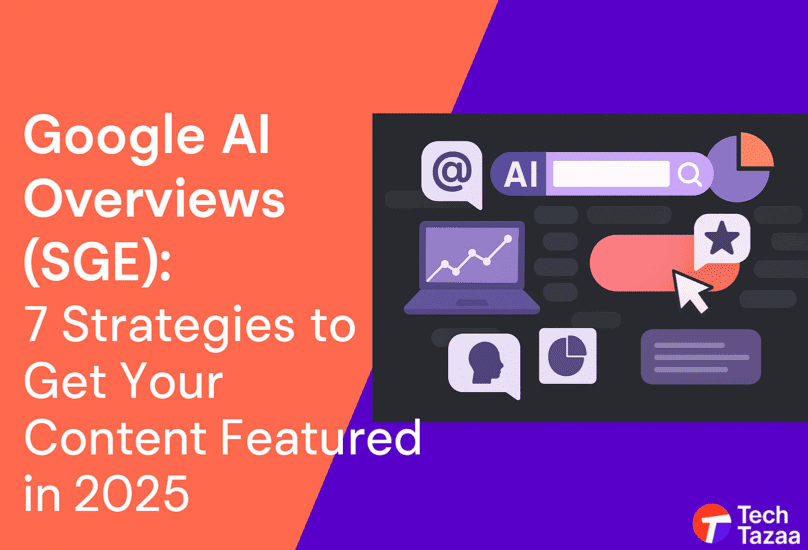The way people discover and consume information on Google has changed forever. In 2025, Google AI Overviews (SGE) are at the center of search results, reshaping how users interact with content online. Instead of simply showing a list of blue links, Google now presents AI-powered summaries that pull together the “best” information from multiple sources.
For brands and publishers, this is both a challenge and an opportunity. Traditional SEO strategies—stuffing keywords, chasing backlinks, or ranking on Page 1—are no longer enough. If your content does not appear in AI Overviews, you risk invisibility in the new search landscape.
But here is the good news: with the right AI search optimization strategies, you can position your website to be featured in AI results. In this article, we will break down 7 proven strategies to master SGE SEO in 2025, helping your content stand out, earn trust, and drive clicks.
What Are Google AI Overviews (SGE) and Why They Matter in 2025?
Google AI Overviews, also known as Search Generative Experience (SGE), are AI-generated summaries displayed at the top of search results. Unlike traditional featured snippets, AI Overviews synthesize insights from multiple high-quality sources, presenting them in a conversational and easy-to-digest format.
Why does this matter? Because these AI summaries are now the first thing users see when searching. Instead of scrolling through ten links, users can scan a concise AI-powered answer that cites sources directly in the overview.
Research from Search Engine Land suggests that over 65% of users trust AI-generated answers as much as traditional search results. Early studies also show that sites referenced in AI Overviews see higher click-through rates (CTR) compared to standard organic listings.
Being featured in AI results translates to:
- Increased visibility in prime real estate.
- Greater brand authority as a trusted source.
- More qualified traffic since Google highlights only the most relevant answers.
In short, SGE is not just an update—it’s the future of SEO.
How Google’s AI Chooses Content for Overviews
If you want to appear in AI Overviews, you need to understand how Google’s AI evaluates and selects content. While Google doesn’t reveal its full algorithm, SEO experts and case studies highlight a few critical factors:
- Relevance & Topical Authority: Content must answer the query directly and comprehensively.
- Content Freshness & Accuracy: AI favors updated, fact-checked sources over outdated pages.
- E-E-A-T (Experience, Expertise, Authoritativeness, Trustworthiness): The stronger your credentials and trust signals, the higher your chance of selection.
- Helpful, People-First Content: Google has repeatedly emphasized that content designed for humans—not just search engines—will win in SGE.
Think of AI Overviews as a curated panel of experts. If your content proves you’re knowledgeable, up-to-date, and trustworthy, Google is more likely to cite your site.
Strategy #1: Optimize for Conversational Queries (AI Search Optimization)
One of the biggest shifts in search is the rise of conversational queries. Instead of typing “SGE SEO strategies,” users now ask: “How can I get my website featured in Google AI Overviews?”
Action steps:
- Target long-tail keywords that mimic natural speech.
- Add FAQ sections to your blogs that directly answer common questions.
- Use headings with phrases like “What is…,” “How does…,” “Why does…” to align with user search behavior.
📌 Example: A blog titled “How Does SGE Impact SEO in 2025?” is more likely to appear in AI results than one simply targeting “SGE SEO.”
Pro tip: Tools like AnswerThePublic, AlsoAsked, and Semrush’s keyword magic tool can uncover trending question-based queries perfect for AI search optimization.
Strategy #2: Build Topical Authority With Deep Content
Google’s AI doesn’t just pull random snippets—it looks for authoritative voices. To stand out, you need to establish topical authority by covering subjects in depth.
How to build authority:
- Create content clusters: Start with a pillar article (e.g., “Complete Guide to Google AI Overviews”) and link supporting posts (e.g., “AI SEO for Beginners,” “How Schema Helps in SGE”).
- Interlink strategically: Show Google that your site is the go-to hub for a topic.
- Use credible data: Cite studies, official Google blog posts, or industry research.
📌 Example: A niche marketing blog that publishes 20+ high-quality articles on SGE SEO will likely outrank a generalist site with only one piece on the subject.
By positioning yourself as a thought leader, you increase your chances of being featured in AI results.
Strategy #3: Use Structured Data & Schema for AI Understanding
AI thrives on structure. If your website is a well-labeled library, Google can easily understand and pull your content into Overviews.
Key schema types to prioritize:
- FAQ Schema – Helps AI extract Q&A style responses.
- HowTo Schema – Perfect for step-by-step guides.
- Product Schema – Essential for e-commerce to showcase reviews, pricing, availability.
- Review Schema – Adds credibility by highlighting user-generated trust signals.
By implementing schema markup, you’re essentially training Google’s AI to recognize your content as contextually relevant and trustworthy.
Recommended tool: Google’s Structured Data Testing Tool or Schema.org validators.
Strategy #4: Prioritize Content Freshness and Updates
Google AI Overviews lean heavily on recent information. Stale content is less likely to be surfaced.
Action steps:
- Refresh evergreen content quarterly with new statistics and insights.
- Add “last updated” tags to show freshness.
- Monitor trends in your niche and update content as industry changes occur.
📌 Example: A 2023 blog on “SGE SEO basics” won’t perform as well in 2025 unless updated with the latest algorithm changes and case studies.
Freshness signals tell Google that your content is relevant today, not outdated.
Strategy #5: Improve E-E-A-T for Trust Signals
Trust is a cornerstone of SGE SEO. Google wants to feature content written by credible experts.
How to boost E-E-A-T:
- Add author bios with credentials and LinkedIn links.
- Showcase first-hand experience (case studies, experiments, original research).
- Secure backlinks from reputable sites in your industry.
- Include transparency elements like contact pages, privacy policies, and citations.
📌 Example: Health articles written by licensed doctors or nutritionists have a much higher chance of being featured in AI results compared to anonymous blogs.
The more trustworthy your content appears, the stronger your presence in Google AI Overviews.
Strategy #6: Optimize Multimedia for AI Inclusion
AI Overviews don’t just summarize text—they also display visual assets like images, videos, and charts.
How to optimize multimedia:
- Add alt text with relevant keywords (e.g., “SGE SEO infographic”).
- Create explainer videos for complex topics and embed them in blogs.
- Use descriptive file names like google-ai-overviews-2025.jpg.
Rich media increases the likelihood of your content being cited in AI results, and it also enhances user engagement.
📌 Pro tip: Infographics summarizing “7 SGE SEO strategies” could easily be pulled into AI summaries, boosting your visibility.
Strategy #7: Align With User Intent for Better Engagement
At the end of the day, Google AI rewards content that solves user problems quickly and effectively.
Action steps:
- Map queries to the buyer’s journey (awareness, consideration, decision).
- Use clear formatting: bullet points, numbered lists, TL;DR summaries.
- Monitor user engagement metrics like dwell time, bounce rate, and scroll depth.
📌 Example: If someone searches “How to rank in AI results,” your blog should offer immediate, actionable steps instead of burying the answer in fluff.
Content that matches intent not only ranks but also keeps users engaged—a signal Google values highly in AI search optimization.
Tracking & Measuring Your SGE SEO Performance
You can’t improve what you don’t measure. Tracking your performance in AI Overviews is key to refining your strategy.
Tools to use:
- Google Search Console – Look for new SGE reporting features as they roll out.
- Semrush & Ahrefs – Some rank trackers now include AI visibility metrics.
- Analytics dashboards – Track engagement, clicks from AI results, and CTR improvements.
KPIs to monitor:
- Impressions in AI Overviews
- Traffic driven from SGE
- Engagement metrics (time on page, bounce rate, conversions)
By analyzing these data points, you can double down on what’s working and refine what isn’t.
Conclusion
Google AI Overviews (SGE) go beyond a simple search update; they represent an evolution in how we find and consume information online. For brands to be included in AI results, they must create new SGE SEO strategies centered around conversational queries, topic authority, structured data, content freshness, trust, multimedia, and user intent.
The seven strategies outlined within this guide are not quick hacks, but rather long-term plays that will help future-proof your digital presence in an AI dominated world.
👉 Begin by refreshing pages of greatest importance to the brand, adding structured data, and realigning content with conversational intent. The sooner you recognize and integrate this shift the greater of a chance your brand will be mentioned in Google AI Overviews, gaining clicks, trust and authority in 2025 and beyond.
FAQs About Google AI Overviews (SGE SEO)
- What is Google AI Overviews (SGE)?
Google AI Overviews (formerly SGE, Search Generative Experience) is Google’s AI-powered feature that generates summarized answers directly in search results, pulling data from multiple sources.
- How is SGE SEO different from traditional SEO?
Traditional SEO focuses on ranking web pages. SGE SEO focuses on being cited or featured within AI-generated answers, requiring clarity, authority, and structured content.
- How can I get my content featured in AI results?
By targeting conversational queries, optimizing with schema, building topical authority, and prioritizing EEAT.
- Will AI Overviews replace regular Google search results?
No, but they will co-exist. Organic results remain important, but AI summaries are becoming a primary discovery channel.
- What tools help track AI search optimization?
- Google Search Console (SGE tracking updates expected).
- AI-focused SEO tools like Surfer, Semrush, Ahrefs, and SGE-specific trackers.


